#variable nebulae
Explore tagged Tumblr posts
Text

The Ghost of Cassiopeia (IC 63) being lit up by the star Navi (γ Cassiopeiae) // Timothy Straub
The star Navi, γ Cassiopeiae, is named for the American astronaut Virgil Ivan "Gus" Grissom who flew in the Gemini 3 mission and died in the onboard fire of Apollo 1. The star's name is his middle name spelled backwards.
#astronomy#astrophotography#nebula#reflection nebula#ghost of cassiopeia#IC 63#IC 59#star#variable star#navi#hey listen!#gamma cassiopeiae#history#etymology#cassiopeia
360 notes
·
View notes
Text
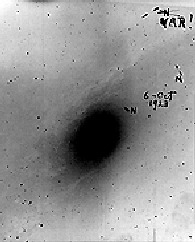
Andromeda Nebula: Var! - April 6th, 1996.
"In the 1920s, using photographic plates made with the Mt. Wilson Observatory's 100 inch telescope, Edwin Hubble determined the distance to the Andromeda Nebula - decisively demonstrating the existence of other galaxies far beyond the Milky Way. His notations are evident on the plate shown above (the image is a negative with stars appearing as black dots against the white background of space). By intercomparing plates, Hubble searched for "novae", stars which underwent a sudden increase in brightness. He found several on this plate and marked them with an "N". Later he discovered that one was actually a type of variable star known as a cepheid - crossing out the "N" he wrote "Var!" (upper right). Thanks to the work of Harvard astronomer Henrietta Leavitt, cepheids, regularly varying, pulsating stars, could be used as "standard candle" distance indicators. Identifying such a star allowed Hubble to show that Andromeda was not a small cluster of stars and gas within our own galaxy, but a large galaxy in its own right at a substantial distance from the Milky Way. Hubble's discovery is responsible for our modern concept of a Universe filled with galaxies."
#nasa#space#cosmos#universe#astronomy#astrophysics#astrophotography#andromeda nebula#cepheid variables
17 notes
·
View notes
Text

MORE ECTO PRACTICE BABEYYY they look like cool rocks this time :]
Reblogs > likes
6 notes
·
View notes
Text

Dark Nebulae and Star Formation in Taurus
3 notes
·
View notes
Photo

2025 January 31
The Variable Nebula NGC 2261 Image Credit & Copyright: Tommy Lease (Denver Astronomical Society)
Explanation: The interstellar cloud of dust and gas captured in this sharp telescopic snapshot is seen to change its appearance noticeably over periods as short as a few weeks. Discovered over 200 years ago and cataloged as NGC 2261, bright star R Monocerotis lies at the tip of the fan-shaped nebula. About one light-year across and 2500 light-years away, NGC 2261 was studied early last century by astronomer Edwin Hubble and the mysterious cosmic cloud is now more famous as Hubble's Variable Nebula. So what makes Hubble's nebula vary? NGC 2261 is composed of a dusty reflection nebula fanning out from the star R Monocerotis. The leading variability explanation holds that dense knots of obscuring dust pass close to R Mon and cast moving shadows across the dust clouds in the rest of Hubble's Variable Nebula.
∞ Source: apod.nasa.gov/apod/ap250131.html
106 notes
·
View notes
Text
Poly! Jegulus x gn! Reader - When there is no logic, look deeper
A/n: I decided to go with a different analogy for James's and Regulus's relation than I normally do (and what everyone else normally does.) So have fun with this little drabble!
Summary: Your relationship with James and Regulus through Remus's perspective.
Warnings: Swearing, brief mentions of child abuse, brief mentions of mental health issues (if you squint,) I think that's it? You have been warned!
The Three P's:
[Pronouns used: you/your] [Pov: 2nd person] [Pairings: (romantic!) (poly!) jegulus x reader, (romantic!) wolfstar, (platonic!) marauders]
I do NOT support J. K. Rowling, or any transphobic/homophobic things she says (or anything she says really), or TERFS!
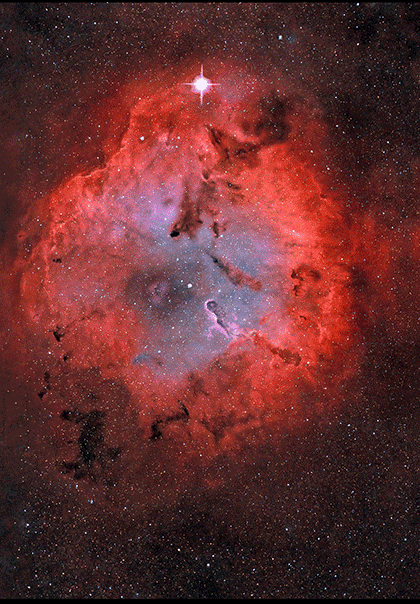
Regulus and James fit together, in a neat messy puzzle. James's darker skin contrasting with Regulus's more pale, like the sun and it's moon. Recently, Remus had been reading some muggle plays of man named Shakespeare, and just by looking at the two, he could tell that he would've written down every piece of their love story, until he knew it by heart.
The enigma, the question, he just couldn't find the answer to was you, because Regulus and James were different sides of the same coin. Slytherin and Gryffindor, light and dark, sun and moon. You just didn't fit as nicely into the big picture.
That's what he used to think anyway, before the marauders and everyone else had gotten to know you. To Remus, he used to think of you as a temporary escape for the two boys, as you were the only one out of the three who had a normal life. It was harsh, but it was the only answer to the equation he could come up with.
Remus's life hadn't been full of answers, maybe that's why he tried to find the solution, so there would be no more variables. So he didn't have to attempt to find the solution later, when they most needed it most. So maybe, just once his life could be left with more answers than questions.
Action reaction, like getting bit by a werewolf - he was one of them now. Finding Sirius, James, and Peter on the train - becoming friends. Gaining feelings for Padfoot, confessing them and becoming a couple. (Okay, maybe there were multiple steps to that equation.) Everything had a solution, something he liked to find to keep himself sane. When everything else in his life was swirled with insanity.
You fitting into the equation didn't follow a path of logic, it was completely and utterly crazy.
Now, he sees what he didn't before, the way you would stay with James even when the smile slipped from his lips. How you would listen to Regulus, and give him space to talk about his family troubles, why he stayed.
You would let James cry, and make Regulus giggle, the planets didn't just revolve around the sun now. Now the moon and it's star revolved around you.
You were a nebula, because when a person looked at you, they gasped in wonder. Everything unknown and beautiful was you, a glittering cloud of normalcy and love. Nurturing but fleeting if need be.
One time, Sirius said he and his brother were the stars, and you only laughed, shaking your head.
"Regulus is like the moon, for so long we thought we couldn't reach him, until we did."
Remus's boyfriend looked startled, Remus could agree with the feeling. How had you, just made sense of someone so complex, with so many strings and layers, with just a sentence?
The werewolf wanted to see how you would respond if he asked you about everybody at Hogwarts, about the ministry, his family. Instead, he asked you about your other boyfriend.
"James?" You smiled softly, and for some reason it warmed Remus's heart, that when you thought about his friend, you immediately were happy. As if just thinking about him was enough to revel in his sunlight.
"James is the sun, he's bright, but sometimes his brilliance gets the peoples eyes, it can annoy them. Until he gets farther away." You still had a pleasant look upon your face, but your eyes were brightly alight with sadness. "Then it's winter, and they long for summer again, because then the sun could be there to warm them a second time. Regardless of its blinding sunlight."
Remus thinks, that was the moment that he started to understand why James and Regulus had both fallen for you. You were the beautiful unknown, a nebula, out of reach, but oh, so beautiful to gaze upon.
Remus still didn't quite comprehend how you fit into the grand scheme of things, but he thinks, he starting to see the big picture.
Words 670
-thedelusionreaderbitch
Hp Taglist: @regulusblackswhorecrux
#delusion writes#jegulus#starchaser#wolfstar#marauders#marauders x reader#platonic! remus lupin x reader#poly! jegulus x reader#poly! jegulus x gn! reader#jegulus x reader#james potter x reader#james potter x gn! reader#regulus black x reader#regulus black x gn! reader#james potter x regulus black#james potter x regulus black x reader#james x regulus#james x regulus x reader#marauders era#harry potter#fuck jkr#hp#harry potter fandom#harry potter x reader
413 notes
·
View notes
Text
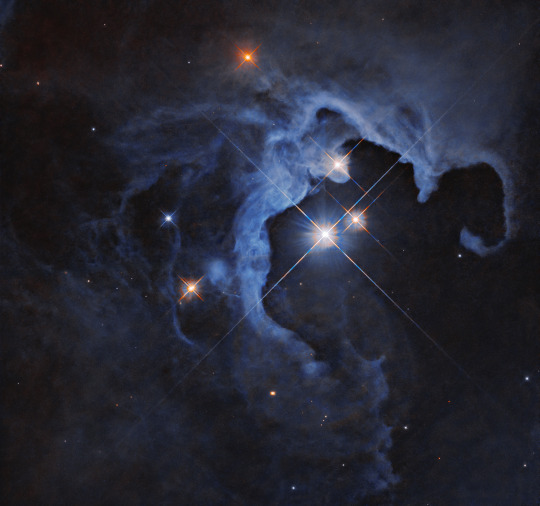
Hubble Views the Dawn of a Sun-like Star | Hubble Space Telescope
Looking like a glittering cosmic geode, a trio of dazzling stars blaze from the hollowed-out cavity of a reflection nebula in this new image from NASA’s Hubble Space Telescope. The triple-star system is made up of the variable star HP Tau, HP Tau G2, and HP Tau G3. HP Tau is known as a T Tauri star, a type of young variable star that hasn’t begun nuclear fusion yet but is beginning to evolve into a hydrogen-fueled star similar to our Sun. T Tauri stars tend to be younger than 10 million years old ― in comparison, our Sun is around 4.6 billion years old ― and are often found still swaddled in the clouds of dust and gas from which they formed. As with all variable stars, HP Tau’s brightness changes over time. T Tauri stars are known to have both periodic and random fluctuations in brightness. The random variations may be due to the chaotic nature of a developing young star, such as instabilities in the accretion disk of dust and gas around the star, material from that disk falling onto the star and being consumed, and flares on the star’s surface. The periodic changes may be due to giant sunspots rotating in and out of view. Curving around the stars, a cloud of gas and dust shines with their reflected light. Reflection nebulae do not emit visible light of their own, but shine as the light from nearby stars bounces off the gas and dust, like fog illuminated by the glow of a car’s headlights. HP Tau is located approximately 550 light-years away in the constellation Taurus. Hubble studied HP Tau as part of an investigation into protoplanetary disks, the disks of material around stars that coalesce into planets over millions of years.
Credits : NASA, ESA, G. Duchene (Université de Grenoble I); Image Processing: Gladys Kober (NASA/Catholic University of America)
#astronomy#NASA#space#hubble space telescope#stars#ESA#Taurus#star#nebula#HP Tau#cosmic dust#light#fav#ref#interstellar#triple-star system#galaxy
196 notes
·
View notes
Text

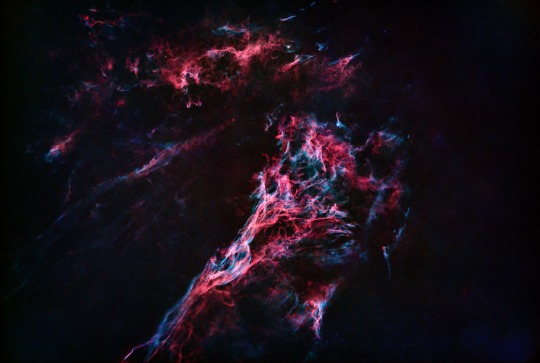
Photo of Pickering's triangle (also known as Fleming's triangle) and NGC 6979 / NGC 6974 (the more diffused clouds at the top center/left). This is the third part of the Cygnus loop / veil nebula, this part of the supernova remnant is fainter than the previous two parts of the loop I photographed. This explains in part why it was only discovered by in 1904 by Williamina Fleming (whereas the two writer part were discovered in 1784 by William Herschel). Williamina Fleming was a pioneer in stellar classification, she worked with other women at the Harvard college observatory. Their work in star classification resulted in the Henry Draper Catalogue, an extensive (225 300 stars in the first edition) classification of stars with their position and their spectra. Williamina is also credited with the discovery of 59 nebula (including the famous hors head nebula) more than 300 variable stars as well as (with Henry Norris Russell and Edward Charles Pickering) the discovery of white dwarfs (the remnants of dead sun-like stars).
#astronomy#astrophotography#space#photos taken from my backyard#supernova remnant#nebula#pickering's triangle#Williamina Fleming
93 notes
·
View notes
Text
✨Friday Kiss Tag 💋✨

✨🌈 Happy Friday, lovelies! 💖✨
Thank you again to the following people who tagged me this week: @zackprincebooks , @jev-urisk , @justabigoldnerd , and @pippinoftheshire for a WIP Wednesday tag, @alinacapellabooks for a roast OCs tag, @tragedycoded for a heads up seven up tag and a last line tag, @theink-stainedfolk for a dialogue, character prompt, and proud snippet tag, @willtheweaver for a writing share tag, @gioiaalbanoart for a mix fried tag, and @drchenquill for a proud of tag!! I appreciate all the love this week while I rest and recover 💛✨
Without further ado, here are the kiss rules 💋:
Rules: From your story/WIP, share a kiss. It can be any kiss, from familial pecks on the cheek, forehead kisses, platonic smooches, to full-blown makeouts
And here are the non-kiss rules 💚:
Rules: Share a snippet of your writing!
Here’s another few lines from these goobers from YWIMC 🧞♂️💖✨:
Opening his eyes, Cauldwell looked up at his lover affectionately. The black and sapphire strands of hair whipped across Ali’s forehead. His eyes, those gorgeous nebulae, looked back at Noah. His world. Those soft lips, slightly bruised from all their hot makeouts, upturned at the corners in a gentle smile. Smiles that painted adoration gleamed brightly in the presence of the two halves brought whole. They fawned over each other, absolutely taken by the other’s beauty.
These lovable dummies (/affectionate) are absolutely smitten, your honor. 💛
Leaving this tag +open as always and letting the tag list know of the writing post. Have a great weekend, everybody! 💫
✨👇Tag List for Writing Snippets Below. DM me if you’d like to be added 👇���
Tag List for writing tidbits (lmk if you want + or -)
@autism-purgatory , @halfbakedspuds , @talesofsorrowandofruin , @ragin-cajun-fangirl , @wyked-ao3 ,
@glasshouses-and-stones , @alinacapellabooks , @gioiaalbanoart , @tragedycoded , @deanwax ,
@dyrewrites , @honeybewrites , @drchenquill , @paeliae-occasionally , @lychhiker-writes ,
@thatuselesshuman , @kaylinalexanderbooks , @phynewrites , @zackprincebooks , @fantasy-things-and-such ,
@finickyfelix , @billybatsonmylove , @madi-konrad , @houseplantblank , @far-cry-from-finality ,
@froggy-pposto , @fractured-shield , @avaseofpeonies , @topazadine , @thecoolerlucky ,
@theaistired , @somethingclevermahogony , @noxxytocin , @the-inkwell-variable , @seastarblue ,
@leahnardo-da-veggie , @addicted2coke-theothercoke , @illarian-rambling , @mysticstarlightduck , @the-letterbox-archives ,
@ominous-feychild , @saturnine-saturneight , @words-after-midnight , @hemlocks-grove , @cowboybrunch ,
@yourpenpaldee , @moltenwrites , @pixies-love-envy , @davycoquette , @writeahurricane ,
@nczaversnick , @greenfinchwriter , @oliolioxenfreewrites , @lavender-gloom , @smellyrottentrees ,
@aintgonnatakethis , @thecomfywriter , @pluppsauthor , @michellekarnold , @flurrysahin ,
@authorcoledipalo , @jadeglas , @spookyceph , @astramachina , @48lexr ,
@inseasofgreen , @agirlandherquill , @saebasanart , @leatafandom , @justabigoldnerd ,
@pippinoftheshire , @just-emis-blog, @aalinaaaaa , @badscientist , @dearunreliablenarrator ,
@worlds-tallest-fairy , @rhikasa , @eccaiia , @theink-stainedfolk , @theverumproject ,
@theprissythumbelina , @riveriafalll , @revenancy , @inadequatecowboy , @amielbjacobs ,
@patternwelded-quill , @sugarchains , @garthcelyn , @prettytothink-so , @the-inkwell-variable ,
@winvyre , @speaknowbuckley , @lamuradex , @wintherlywords , @sharkblizzardblogs ,
@dragoninatrenchcoat , @darekasama , @recklessgirl56 , @kokoass , @ziote ,
@paletteofseaglass , @basketcase1880 ,
@twopercentboy , @mxtansy , @menaceofmemory , @unfilteredmoonchild , @blerdsong ,
@iamwhimsy , @beansmakesthings , @birdycage , @tiagems , @narkaholic ,
@irolynn , @petitprincess1 , @macinchiz , @owlsandwich , @stephtuckerauthor,
@sarandipitywrites , @mauvecatfic , @finchwrites , @aurumni-writes , @uiraya ,
@justanotherchangeling , @ahopelessnecromantic , @ryns-ramblings , @oleanderbailey , @365runesofthesystem
#writeblr tag games#friday kiss tag#kiss tag#writing share#spilled ink#heads up seven up#goldencomet💫#ywimc#genie slice of life novel#college life novel#magic in the mundane#and they were roommates#bl romance#romance writers#creative writers#creative writing#writers on tumblr#writeblr#writblr#writerscommunity#writing community#writeblr community#writers on ao3#ao3 community#writers#writing#writer stuff#writing things#writers and readers
58 notes
·
View notes
Note
I'm wondering what's the difference between Catholicism and other denominations, I know the main things are the pipe and the virgin Mary actually being respected, but I like to hear from someone whose passionate.
Also it's really funny to think someone going like "She's Jesus adjacent but she had an epidural from god so it's not that big a deal"
(I say godly epidural because how else is childbirth a silent night)
yoooo hello friend thank you for your message :))) assuming this is continuing in some sense from earlier things said whilst reblogging so I'm gonna approach it with that in mind
So there's two good ways of visualising the difference between various flavours of Christianity:
Firstly, as three paradigms, rather than specific Church Groups per se.
Catholicism is a unity-in-truth-variety-in-practice paradigm: we all believe the same things, united under one leader and a centralised way of forming beliefs. How exactly those beliefs are put into practice (eg in different liturgy styles) is more flexible, leading to a range of "rites".
Orthodoxy is a unity-in-practice-variety-in-beliefs paradigm: the liturgy and iconography and expression of the faith is critically important as practical modes of theology (much less written teaching than catholics!), and they have a sort of nebula of hierarchies that have variable relationships with each other and variable theological approaches to a given topic. Important to note that despite the slightly chaotic organisational structure, they have maintained almost exactly the same beliefs as Catholics, but verbalised differently, which leads people to think they're different beliefs (eg. Filioque, Dormition vs Assumption).
Protestantism is a non-unity-total-variety paradigm, wherein beliefs and practice are both determined on a micro-level, leading to a rather volatile structure where schism is common and somewhat expected-- practically speaking the laity get on with things without paying much attention to the schisms, forming what I affectionately call "the Protestant soup".
This paradigm problem broadly boils down to a problem of authority-- when there is a disagreement between two arguments (which may both be reasonably proven from scripture), who decides? and how can you trust the decision? We'd say that the Catholic Church continues to be guided infallibly by the Holy Spirit, just as the Church of the early centuries was guided to correct belief on 1) the trinity 2) the canon of scripture and 3) whether gentile converts should be circumcised. Protestants reject this but imho never came up with a convincing alternative, leading to the chaotic nature of the paradigm as a whole.
Secondly, and this is a biased opinion as someone who converted to Catholicism from a historically Protestant culture, it seems to me useful to consider how Protestant theology (paradigmatically) developed from Catholicism. I know it doesn't necessarily occur to people from Prot-majority countries that Catholicism is actually the default Christianity, and that they're the innovation, but it's a really elucidating realisation. You have to see Protestantism as inherently a reaction to Catholicism, and something that has to define itself in relation to Catholicism.
To summarise: the various strains of the Reformation (Calvinism, Lutheranism, Zwingliism, Anglicanism, etc) are all based off the assumption that Catholicism somehow had "too many" beliefs, that needed to be reduced to reveal a "purer" form of Christianity.
The truth is that while Catholicism seems very maximalist, and like it has a lot of "extra" things (saints, Marian devotion, feast days, confession, bigger bible, fasting practices, monastic charisms, etc etc etc), the truth is that all of these things form a very rich, interlocking system of theology, where every belief is dependent on every other belief. How you understand Mary's role as Theotokos is dependent on a correct understanding of Christ's dual nature, which depends on a rejection of Gnostic dualism, which then gives you a proper sexual ethic and an understanding of the Incarnation, which then links back to the Immaculate Conception, which gives you the Assumption, which explains why you need to go to confession before receiving the Eucharist, etc etc. It sounds a bit overwhelming but when it starts to fall into place you see that every single thing works in this tightly symbiotic ecosystem of doctrine, all of which works to magnify God. The "extra" things are enriching, not distracting.
So when you get the Reformation, and Protestants start subtracting things willy-nilly, the ecosystem starts to fall apart and mutate in strange ways. Protestant groups then separate and keep mutating based on what each one wants to subtract. The Anglican church is a good example of this-- they started by having Catholicism, but subtracting the idea that marriage is an unbreakable covenant (Henry VIII wanted a divorce). This leads to mutation in the understanding of marriage as a sacrament, leading to 2 sacraments rather than the traditional 7, which then nukes confession, holy orders, anointing of the sick, and confirmation. If you don't have holy orders, you lose the theology of the eucharist, which in a lot of Anglican churches is now seen as symbolic (or near enough). if you lose the real presence in the eucharist, your incarnation theology is now buggered. Similarly, as we were discussing in the other reblogs-- Calvinism and Lutheranism both lose the idea of indulgences, when then loses the idea of purgatory, which means you lose a proper understanding of sanctification (theosis), leading to once-saved-always-saved, meaning the Crucifixion, instead of being this great act of Love, is now a legal transaction of salvation, which reconfigures how guilt and contrition work, and which once again buggers your eucharistic theology because the emphasis on it as a one-time event means you've lost the mystical and constant resonance of calvary through all time. All of this then knocks onto how you build churches-- the altar is now no longer front and centre, because the Old Testament sacrifice is not present anymore, so you have a big-ass pulpit and the service is centred around preaching, not around the sacrifice of the Mass. Ironically, though the Reformers aimed to have a more Christ-centric Christianity, the change in how they fundamentally do church services illustrates exactly how you actually end up with a man-centric church that puts Christ off to the side. And that's not even getting into how Luther removed books from the Bible to support his own theology.
I would say that the continuous nature of Catholicism (and Orthodoxy, to a lesser extent) from a) the Judaism of the Old Testament and b) the church of the first few centuries is really very critical. John Henry Newman's Essay on the Development of Doctrine is the seminal work on this (very readable, 100/10 would recommend). The sacramental priesthood is a continuation of the Levitical priesthood, the sacrifice of the mass is the fulfilment of Temple sacrifice (SUPER important in the OT-- the Torah goes on for pages and pages and pages about it), the Pope is the continuation of figures such as Moses and David, who are also Christ-types. I've got a friend converting to Catholicism from Orthodox Judaism and she keeps pointing out to me similarities that I didn't even know existed. On the Early Church-- you'll see a lot of quote-mining from both sides, but the key points that are really indisputable are 1) the idea that the bread and wine literally transform in some mystical way and 2) that the Church is united in an episcopal structure, with an emphasis on Rome as primus inter pares (the first among equals). What exactly this second point entails is why the East and West split-- my view is that the current fiasco in Moscow proves that the Pope is necessary but that's another essay-length post.
Doctrinally of course there's a lot of haggling over specifics eg. the Virgin Mary, soteriology, eucharistic theology, etc etc etc and my impression is that Protestants generally try to justify their beliefs in two ways: 1) Rome is entirely wrong and we're not related to them in any way (really low church baptists, anabaptists, pentecostals, etc) or 2) Rome is wrong but also we believe the same things as Rome and are completely different to stereotypical Protestants (anglicans, lutherans, presbyterians). Both of these approaches IMO demonstrate the truth of Catholicism, because group 1 are just demonstrably so far away from OG christianity that they cannot reasonably argue that they're more authentically Christian than Catholics-- at best these two are equally bad and group 2 seem to implicitly know that Rome is right, because they justify themselves by disavowing anything that isn't ostensibly Catholic and allying themselves with Catholic beliefs as much as possible. The truth is that we can get really bogged down in the specific details of oh Calvin actually said this or maybe Augustine actually meant that, but it doesn't really matter when the overall paradigmatic approach is so far removed from the first 1500 years of Christianity. The idea that you can have multiple churches believing different things and all being equally authentically Christian is a total invention of the Reformation, and quite frankly, a disservice to the lay faithful who didn't ask to be bogged down in all of this anyway.
Finally, to round off this abhorrently long answer to your question (apologies!!!)-- sacramentality and the concrete motion of grace are really important concepts. For Catholics, the motion of God's grace and divine action are really concrete things. Grace comes through the sacraments, which are literally what they say they are. Mary appears sometimes and tells us things. Miracles literally happen. The saints are part of our community and you can talk to them and ask them for things. Their bones are pieces of that which is holy. The action of God is a very real and close part of the practice of the lay Catholic that can be studied and analysed in quite a scientific manner (look up how the Vatican approves miracles, for example!), and which the lay person interacts with in the same way they'd interact with any other part of their life. There's a quote from someone (Eamon Duffy??) that goes something like: for the mediaeval Catholic, Purgatory, Heaven, and Hell were places as real as Canterbury or Dover. Part of the Protestant paradigm involves spiritualising: Christ is not bodily present in the Eucharist, but spiritually, the saints are just any and all Christians, and heaven stays in heaven until you get there yourself. It's partly why Newman argues that this kind of spiritualised belief naturally tends towards atheism-- it's lost the sense of hard reality.
Hope that's at least somewhat helpful-- as I say, you can get bogged down in long lists of where beliefs differ, but I think given the rather broad and variable nature of Protestant beliefs, it's unhelpful to try to distill them down into A List. Similarly, because Catholic beliefs are so interdependent, it's really difficult to make the case for one belief without bringing in other parts of the network, which is why Prot-Cath dialogue often ends up going in circles quoting scripture or the church fathers and nobody wins. Feel free to ask further about anything if you can face another long answer (probably won't be quite as long as this!), and god bless you. I'll say a Hail Mary for you to find whatever it is that you need to find.
#catholicism#protestantism#askjhn#christianity#cathblr#christblr#this answer is abhorrently long so maybe make a cup of tea and brace yourself before clicking 'expand'
40 notes
·
View notes
Text

Hubble's Variable Nebula, C46 // Kent Wood
The bright star at the corner of the "fan" is R Monocerotis, a very young binary star system. Light from this star lights up the nearby cloud of gas and dust, but observations over just weeks shows that the nebula changes brightness. One explanation is that dense clouds of dust near R Monocerotis pass in front of it, periodically blocking light and casting a shadow on the nearby clouds.
#astronomy#astrophotography#caldwell catalog#nebula#reflection nebula#variable nebula#hubble's variable nebula#NGC 2261#caldwell 46#C46#monoceros
68 notes
·
View notes
Text
HIND'S VARIABLE NEBULA - NGC1555, Reflection Nebula - Deep Sky 1508mm LRGB - Constellation Taurus

#astronomy#nasa#astronomers#universe#astrophotography#nasa photos#astrophysics#outer space#nasawebb#hubble space telescope#i love astronomy#astronomy facts#astronaut#astro observations#space exploration#space#science#james webb space telescope#science facts#planetary science#planet earth#cosmos#galaxy#galaxies#the universe#solar system#deep sky#sky photography#space photography
88 notes
·
View notes
Text

The bright variable star V 372 Orionis takes center stage in this image from the NASA/ESA Hubble Space Telescope, which has also captured a smaller companion star in the upper left of this image. Both stars lie in the Orion Nebula, a colossal region of star formation roughly 1,450 light-years from Earth.
Image credit: ESA/Hubble & NASA, J. Bally, M. Robberto
810 notes
·
View notes
Text

Bright Stars, Dim Galaxy - October 14th, 1996.
"These two clusters of bright, newly formed stars surrounded by a glowing nebula lie 10 million light years away in the dim, irregular galaxy cataloged as NGC 2366. The Hubble Space Telescope image shows that the youngest cluster, the bottom one at about 2 million years old, is still surrounded by the gas and dust cloud it condensed from, while powerful stellar winds from the stars in the older cluster at the top (4-5 million years old), have begun to clear away its central areas, giving the entire nebula an apparent hook shape. Compared to the Sun, the stars in these clusters are massive and short lived. The brightest one, near the tip of the hook, is a rare luminous blue variable with 30 to 60 times the mass of the Sun - similar to the erruptive Eta Carina variable in our own Milky Way. Stars this massive are extremely variable. A comparison with ground-based images indicates that in three years this star's brightness increased by about 40 times, making it the brightest star in this dim galaxy. Studies of such distant and diverse galaxies yield clues to the relationships of star formation and galactic evolution."
23 notes
·
View notes
Text
Algol and Perseus
The rescuer and the demon
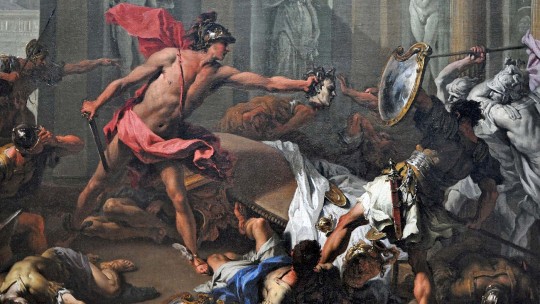

Sebastiano Ricci Antonio Canova
Algol is the beta star of the constellation Perseus, currently sitting at 26° Taurus, known as “the demon star” or "blinking demon", its name comes from the arabic Al Ghul meaning "the demon". To hellenistic astrology it represents Medusa’s head, which Perseus holds on one hand, while on the other he has his sword. An important characteristic of Algol is that its glow has a regular variation, it loses half of its brightness for hours and then it gains back. It was believed by astrologers to be an eclipsing star, which means that another non-visible body would be orbiting it and therefore eclipsing its light from time to time. They were half right, because it was later discovered to be an eclipsing star system, and that Algol was actually 3 stars, just like the Gorgon sisters are three: the imortals Stheno and Euryale, and the mortal Medusa. This is such a hallmark of Algol that it gave its name to its class of eclipsing variable: Algol variable.
Eclipses are associated with death, basically because light in astrology is life-giving, and loss of light is death. But it’s interesting that it's frequently associated with the "demonic", capital punishment and decapitation. Algol is telling a story about the decapitation of a “demon”, just like the lunar nodes (Rahu and Ketu) do in the Jyotish tradition when they cause eclipses. Ptolemy only tells us that the constellation of Perseus is like Jupiter and Saturn. Although Robson agrees with Agrippa about Algol specifically being of the nature of Saturn-Jupiter, and “the most evil star in the heavens”, causing a lot of fear whenever we see it activated in a chart. But I’m not here to scare anybody, don’t worry. It’s difficult, but I’ll try to lighten this up, because the most overlooked fact about Algol is that it also protects and can make revolutions and revolutionary heros.
"Perseus is like Jupiter and Saturn: but the nebula, in the hilt of the sword, is like Mars and Mercury." (Ptolemy - Tetrabiblos) "It causes misfortune, violence, decapitation, hanging, electrocution and mob violence, and gives a dogged and violent nature that causes death to the native or others. It is the most evil star in the heavens" (Vivian E. Robson - The Fixed Stars and Constellations in Astrology)
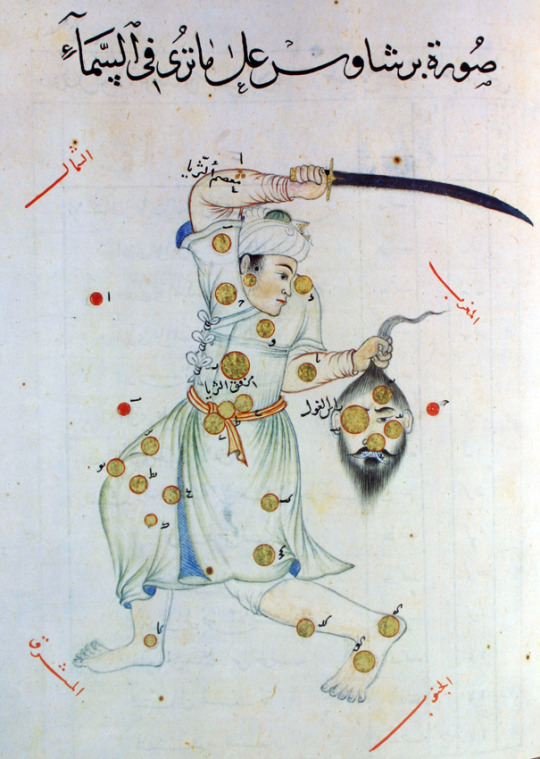

Illustrations from Al-Sūfī's book of fixed stars
Eletrocution or electrical problems are an issue with eclipses and apparently also eclipsing star-systems like Algol. This is noted by Christopher Warnock about his Algol talismans:
"I have had multiple reports and have myself experienced Algol’s tendency to cause electrical and electronic interference when the talisman is first used. I mysteriously lost my Internet connection for an hour and my electronic thermostat died. One user had his entire block lose power. Less frequently but still regularly clients have reported that while wearing their Algol talisman, “weird” or “freaky” people took one look at them and fled." (Christopher Warnock - Fixed star, Sign and Constellation Magic)
Other one of its proeminent themes is vengeance, or the dichotomy of justice vs vengeance, but the effect of reflecting back evil that's sent towards its direction, or of ending curses describes it better in my opinion. About the images of the fixed Behenian stars, Agrippa says that:
“Under Caput Algol, they made an image whose figure was the head of a man with a long beard, having a bloody neck. This brought the good outcome of petitions, gave the bearer boldness and nobility, preserved members of the body from injury, helped against sorceries, and reflected evil attempts and evil incantations from enemies”. (Agrippa's Three Books of Occult Philosophy - Eric Purdue's translation)

Piero di Cosimo
This protection side of the star is illustrated by the story of the champion Perseus not just decapitating the demon but using its head to free Andromeda from her chains and saving her and her city from another monster, and then Athena herself starts using the head of Medusa as a symbol on her shield. As established, this is a star of the nature of Jupiter and Saturn. The nature of Saturn is evidenced even by the names given to the star: demon, cacodaemon, which is also the greek name for the 12th house. Imprisonment, monstruosity and madness are clearly the most important Saturn and 12th house themes. But Algol is a protective star, particularly in astrological magic, although I'll show how this kinda manifests in nativities as well. Algol is mainly of a jupiterian nature, that's why it does liberates. The head is an evil daemon but also a protection amulet. This is interesting regarding the eclipsing factor and the similarity of the significations with the Jyotish Rahu and Ketu. In western astrology the nodes are considered to have effects like Jupiter and Saturn, and the topic of imprisonment-liberation is explored in the dynamic of the two*.
With the new interpretations of the Medusa myth, some astrologers say that Algol can be about "female rage" or "dark feminine", or "feminine jealousy" etc. I think this is one of the stories that people mix the astrological meaning with the morality of the greek myth associated with the star the most. The greek myth is not really the star and the star is not the greek myth. In my opinion, you always must take into consideration that some things can be just the way the greeks or romans viewed a certain theme, and of course they would put a violated woman to represent a monster on a mindless vendetta, and it's not meant to be complimentary. I believe that's already way beyond Algol's effects, it could be just their misogyny projected onto the stars. I can think of examples where I can see that kind of story taking place, but that doesn’t mean that the star is about those things, but just that this is one possibility because we live in patriarchy and things around women's issues can get ugly in an Algol manner. The star can be about capital punishment, monstruosity, madness, captivity, violation, injustice, vengeance, evil daemonic influences etc, but it's not really about cishet women. So, even though I’m also using the greek myth here, I’m not giving the most importance to the detail that it is a story about a woman receiving unfair punishment and that there's a lack of comradery between women, because I'm interested in the star beyond what greeks and romans said, because the stars can’t be represented by just one hegemonic narrative. A lot of other cultures had their different stories about Algol, the Medusa one isn’t special to the point that we could assume every detail about it, even its moral issues (which are also in this case suffering a bit from anachronism), has meaning for the star associated.
Perseus is a spring time constellation very near the bull (taurus), and that may sound too nice for such a scary one. But in babylonian astrology, the stars of Perseus actually formed the constellation of the Old Man, who also held a decapitated head and a rod instead of a sword. Of it, Gavin White has an interesting perspective to share:
“At this time of natural abundance, the earth was thought to ‘open up’ in order to yield her bounty, but to the archaic mind this opening up was accompanied by a host of dangers, chief of which was the potential pollution from the dead who could gain easy access to the upper worlds at this pivotal time. In light of this belief, I would suggest that the Old Man, with his wand and prophylactic head, is banishing the ghosts of the old year and driving them back to the underworld.”

Illutration from Gavin White's Babylonian Star-Lore
There's a lot of examples of charts for literal decapitation or capital punishment, injuries to the head or neck area as obvious manifestations of the star: The most famous is probably the catholic Saint George, who is said to have been executed by decapitation on April 23 back when that was the time of year when the Sun would conjunct Algol, and he later became associated with the constellation. Back then, Algol was at 2° Taurus. Gianni Versace, who had Algol on the descendant, famously made Medusa the logo of his brand and also died with a bullet to the head. Freud had Mercury with Algol, his 8th house ruler, and he died with throat cancer. Nick Yarris, who spent two decades on death row after he was wrongfully convicted of murder, has the Sun with Algol. Patrick Henry had Jupiter, and he was a murderer whose case influenced the abolition of the death penalty in France, which was done by the method of guillotine until its abolition. He was defended by Robert Badinter, who was an activist against the death penalty and could sucessfully propose its abolition in 1981. Badinter has Jupiter with the alpha of Andromeda in the first house. France has a thing with decapitation, some of the charts for its republics have either Algol or Mirfak activated, the alpha star of Perseus.
Algol and Madness
But I want to talk about Algol's special relationship with madness, in the demonized/criminalized sense, because after all, "the demon" is unwanted, it frequently represents the marginalized and their opression. In Brazil's history, especially during the military dictatorship organized and imposed by usamerican capitalist imperialism, asylums imprisoned and tortured mainly black people, women and queer people. Some asylums got so overwhelmed that they became concentration camps, like the famous case of Hospital Colônia in Barbacena, known as the Brazilian Holocaust case, where people died by the thousands from starvation, hypothermia, anemia, STI's, untreated diseases from the lack of hygiene etc. Some important psychiatrists, psychologists, psychoanalysts have Algol activated by some planet. Freud has Mercury, Fritz Perls has Jupiter, David Healy, who literally has a book titled "The Decapitation of Care", has Venus. But what's more interesting to me is the protection element of Algol in some cases and its role in mad liberation movements, after all, Perseus is a liberator. Algol shows up in very important people in the pysch field who question medical power and have antipsych views, and on important events of the psychiatric reform.



Hospital Colônia de Barbacena - MG
Franco Basaglia, the main responsible for the dismantling of psychiatric hospitals and for the psychiatric reform in Italy and for inspiring the one in Brazil, had the Moon with Algol in the 10th house, representing his deeds, while ruling the 12th. In Italy, the Law 180 (Basaglia Law), the Psychiatric Reform law that determined the progressive extinction of asylums throughout the italian territory, was sanctioned with the Sun on Algol. In Brazil, on May 18, 1987, the exact day of the year that the Sun conjuncts Algol, a meeting of mental health workers at a conference was the major milestone for Brazilian health reform and the anti-asylum movement. And since that event, May 18th has become our national anti-asylum movement day, and it becomes more and more culturally relevant as a day to discuss psychiatric reform and the fight to guarantee the rights and autonomy of mental patients.



Marches on May 18th
An important activist, Austregésilo Bueno, born with the Sun with Algol, survivor of compulsory hospitalization in asylums in the 70s, wrote a book "Canto dos Malditos" about his horrible experiences as a psychiatric patient treated with eletroshock therapy (another one of Algol's effects). He had his book adapted to film and his story played by the actor Rodrigo Santoro, who has Algol on the Ascendant. The name of the film is Brainstorm in English, but I find the original "Bicho de Sete Cabeças" much more compelling. It's a truly devastating story, and it's the story of thousands unfortunately.
One thing about Saturn and madness is the recurring idea of wearing masks. Masks and theatre have always been associated with Saturn. Saturnalia was a roman festival where all the roles switched, where kings pretended to be fools and fools pretended to be kings. In modern astrology Saturn ended up associated a lot with a raw and harsh reality, disregarding the most mystical and unreal characteristics of Saturn that have always been present. Although life, reality, identity and reason are always a performance, we're always wearing a mask and performing life. There's a point in the movie "Bicho de Sete Cabeças" when the protagonist is having a difficult time on his first days of being an inmate, he's fighting too much against the forced treatment and expressing too much unsatisfaction with his imprisonment, thus getting even more forcebly medicated and punished by the staff. At this point one of the older inmates shares an important advice with him:
"You have to pretend, who in this world doesn't pretend? You have to say that you're in a good mood, you have to say that you're not hungry, you have to say that you don't have a toothache, you have to say that you're not afraid, otherwise you can't do it, you can't do it. No doctor ever told me that hunger and poverty can lead to mental disorders, but those who don't eat become nervous, those who don't eat and see their family go without eating can go crazy, a discontentment can lead to madness, a death in the family, the abandonment of the great love. We even need to pretend to be insane when we're insane, pretend to be a poet when we're a poet."
It's a powerful speech about the farce of medicine's ownership over the subject of madness, the farce of reason and that it must subjugate or dominate madness. Pretending and acting out the platonic ideal behavior at all situations under all circumstances, as if it's normal, that's the only way anyone is seen as sane.



Bicho de Sete Cabeças (2000)
Another important date in brazillian history is the 13th of May 1888, the day of the passing of the law that abolished slavery, which also had Algol activated by the Sun. This was obviously not the definite end of slavery and not the end of the struggle of black brazilians, just like the Basaglia Law didn't mean mad liberation, but I'm just demonstrating how powerful Algol is to protect from evil and put an end to injustice in an official and legislative manner. Like Saint George defeating the dragon, Perseus defeats a monster that is impossible to defeat, the "impossible victory" and liberation is recurrent in the stories linked to it. Systemic opression and injustices a lot of times seem like impossible problems, it becomes harder and harder to imagine a world where they don't exist, but Algol events revolutionize the impossible.
"The important thing is that we have proven that the impossible becomes possible. Ten, fifteen, twenty years ago it was unthinkable that a mental hospital could be destroyed. Maybe mental hospitals will return to being closed and more closed than before, I don't know, but in any case we have demonstrated that the mad can be cared for in another way, and testimony is fundamental. I don't think that the fact that an action manages to energize itself means that it has been won. The important point is another, it is that now we know what can be done." (Franco Basaglia - Conferenze brasiliane)
An important honorable mention should be made to Carlos Marighella, a guerrilheiro in the resistance of the brazilian military dictatorship who was executed before he could see our democratization. He had Mars with Algol.
"The urban guerrilheiro is an implacable enemy of the government and inflicts systematic harm on authorities and men who dominate and exercise power. The main work of the urban guerrilheiro is to distract, tire and demoralize the military, the military dictatorship and repressive forces, and also attack and destroy the wealth of north americans, foreign managers, and the Brazilian upper class. But the fundamental and decisive characteristic of the urban guerrilheiro is that he is a man who fights with weapons; given this condition, there is little chance that he will be able to pursue his normal profession for a long time or the reference of the class struggle, since it is inevitable and necessarily expected, the armed conflict of urban guerrilla against the essential objectives: A. The physical extermination of the leaders and assistants of the armed forces and the police. B. The expropriation of government resources and those who belong to the big capitalists, landowners, and imperialists, with small expropriations used to maintain the individual urban guerrilheiro and large expropriations for the support of the same revolution. (Carlos Marighella - Manual do Guerrilheiro Urbano)
Algol in Cannes
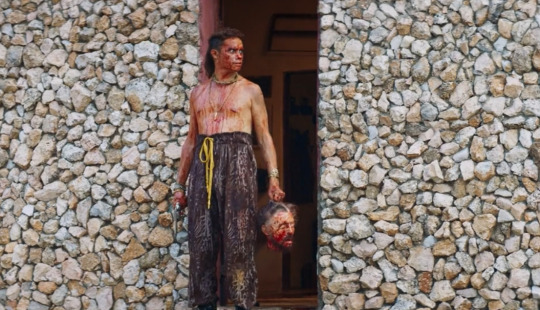

Lunga in Bacurau (2019), the first queer Perseus I know. The actor Silvero Pereira has Venus on Algol.
I’ve said here before how much I love Bacurau. The movie premiered in Cannes, on May 15, 2019, at 10 pm**. This is a chart full of fixed stars, with the Sun with Algol in the 6th house. You'll find in the film the Algol classic of extreme injustice being overcome. But one curious thing is that the Cannes Film Festival always happens around the same time of year when the Sun is at the last degrees of Taurus and beginning of Gemini, making a lot of the movies premiered at Cannes have Algol activated. And it shows. It’s a great opportunity to watch how varied the Algol themes can be. On that same year of 2019, they had: THE DEAD DON’T DIE by JIM JARMUSCH, a pretty obvious Algol movie about zombies, whom you defeat by cutting off the head, of course; LES MISÉRABLES by LADJ LY, inspired by a real-life event of police violence that inspired the 2005 riots in Paris, it seems to have a very radicalized discourse about raging against violent injustices; ATLANTIQUE (ATLANTICS) by MATI DIOP has dead unpaid workers coming back as spirits possessing their city’s inhabitants to take vengeance on the tycoon who withheld their payment; LITTLE JOE by JESSICA HAUSNER is a film about a lab created flower that alters people's behavior in strange ways, and these last two kinda have the feeling of that "spring danger" Gavin White talks about. DOLOR Y GLORIA (PAIN AND GLORY) by PEDRO ALMODÓVAR has Antonio Banderas as the protagonist who develops dysphagia, caused by a caucified growth in his neck. Etc. And these are all just some of the 2019 films. I haven't watched most of them, but you can always look for the films which had their first screenings around 14-20 of May and they'll be rich in Algol content.
So, I'll leave you with that: a bunch of movie recommendations. Thank you for reading.
--
*Adam Elenbaas has my favorite content on the subject of the nodes or Rahu-Ketu.
** You can research the screening guide for an edition to find the time.
#algol#hellenistic astrology#traditional astrology#perseus#mirfak#fixed stars#taurus#taurus sun#taurus moon#taurus asc#sun with algol#astrology#astrology readings#agrippa#ptolemy#astrological magic#astro magic#andromeda#medusa#12th house#saturn#cacodaemon
93 notes
·
View notes
